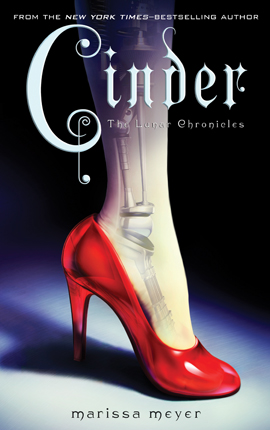Full Text Reviews: Booklist - 10/15/2011 There’s a lot of moving parts in this fresh spin on “Cinderella,” the first in a four-book series. First, we’ve moved from a fairy-tale kingdom to a post–World War IV future in New Beijing. Plagued by her stepmother and shunned by society for being a cyborg, Cinder keeps her head down as the city’s best mechanic until she catches the eye of the dashing Prince Kai. He’s got matters of state to worry about, though, including an incurable plague and the ever-present threat of war from the moon-people, known as Lunars. The over-the-top, spiteful cruelty that dogs the heroine from all sides is a little too cartoonish to take seriously when retrofitted from fairy tale to science fiction, and it’s best not to ponder things like why such a technologically advanced civilization would get into such a tizzy about a fancy-dress ball. Still, readers will enjoy lining up the touchstones from the old favorite, and Meyer brings a good deal of charm and cleverness to this entertaining, swiftly paced read. - Copyright 2011 Booklist. School Library Journal - 01/01/2012 Gr 7–10—This re-imagined fairy tale, the first of a quartet, is neither imaginative nor compelling enough to keep readers involved in the detailed plot. In New Beijing of the Eastern Commonwealth, citizens are plagued by a deadly disease called lutumosis and are in constant danger of being obliterated by a moon-dwelling population called the lunars. Cinder is a human with surgically implanted robot parts who lives with her stepmother, two stepsisters, and an android named Iko. She slaves away as a mechanic, working hard to fix robots, hovercrafts, and netscreens. One day a hooded stranger walks into her booth at the marketplace with a broken android. To her shock, it is Prince Kai. The teen is flustered by the handsome young man who is soon to be emperor but manages to hide her mechanical arm and foot, which would reveal that she is a lowly cyborg, and agrees to help him. Meanwhile her stepsisters, Pearl and Peony, are readying themselves for the ball, intended to help Prince Kai find a princess. After Peony becomes afflicted with lutumosis and is taken to quarantine, Cinder's stepmother volunteers her hated stepdaughter for research in a desperate attempt to save her. With the help of a strange yet kindly doctor, Cinder learns a shocking secret about her past that could help save Prince Kai's empire, if only she can figure out what it means. The author's skilled, concise writing style cannot save this lackluster tale that has way too obvious secrets. Die-hard retold fairy-tale lovers who are also fans of future worlds such as that in Scott Westerfeld's "Uglies" series (S & S) might enjoy this one, but otherwise it is an additional purchase.—Tara Kehoe, Plainsboro Public Library, NJ - Copyright 2012 Publishers Weekly, Library Journal and/or School Library Journal used with permission. Bulletin for the Center... - 02/01/2012 Singing mice and glass slippers are replaced with snarky androids and mechanical feet in this richly imagined and darkly subversive retelling of “Cinderella.” Part human, part robot, Cinder is considered a second-class citizen by the Eastern Commonwealth, so when her malicious stepmother volunteers her as a test subject for the latest (and most likely fatal) experimental antidote for the plague that ravages New Beijing, she can do nothing but comply, even if it means missing the annual royal ball. The results of the test, however, reveal that not only is Cinder immune to the plague but that her origins-which orphaned Cinder has never known-place her squarely in the middle of the political battle that threatens to send Earth into war with the Lunar colonies of the moon. Savvy readers will see where this is headed long before the story gets there, but they will nonetheless delight in catching the cleverly disguised references to the traditional tale along with a few nods to other classics (including one that hints at the direction of the series’ next installment). The focus on both the abilities and limitations of Cinder’s body is particularly interesting as a contrast to the fairy tale’s emphasis on beauty; although the link between Cinder’s struggle and body image issues is never directly made, the scene in which she shows up at the ball entirely herself and unapologetic for it will resonate deeply with teen readers. The science behind Cinder’s cyborg condition isn’t always convincing, but the prejudices against her are clear, as is the social hierarchy that guides the motivations of secondary characters and makes for an engrossing setting. Sci-fi buffs and fairy-tale fans will find the genres easily compatible in this mash-up. KQG - Copyright 2012 The Board of Trustees of the University of Illinois. Loading...
|



